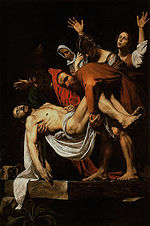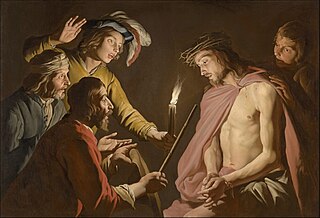
The Passion is the short final period before the death of Jesus, described in the four canonical gospels. It is commemorated in Christianity every year during Holy Week.

Herod Antipas was a 1st-century ruler of Galilee and Perea. He bore the title of tetrarch and is referred to as both "Herod the Tetrarch" and "King Herod" in the New Testament. He was a son of Herod the Great and a grandson of Antipater the Idumaean. He is widely known today for accounts in the New Testament of his role in events that led to the executions of John the Baptist and Jesus of Nazareth. His father, Herod the Great, was described in the account as ordering the Massacre of the Innocents, marking the earliest Biblical account of the concerns of the government in Jerusalem regarding Jesus' existence.

Joseph ben Caiaphas was the High Priest of Israel during the years of Jesus' ministry, according to Josephus. In the New Testament, the Gospels of Matthew, Luke and John indicate he was an organizer of the plot to kill Jesus. He famously presided over the Sanhedrin trial of Jesus. The primary sources for Caiaphas' life are the New Testament, and the writings of Josephus. The latter records he was made high priest by the Roman procurator Valerius Gratus after Simon ben Camithus had been deposed.
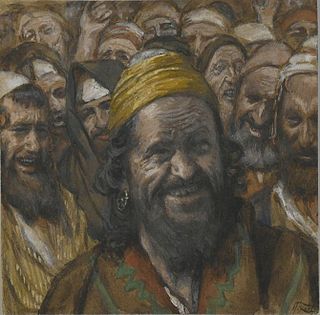
Barabbas was, according to the New Testament, a prisoner who was chosen over Jesus by the crowd in Jerusalem to be pardoned and released by Roman governor Pontius Pilate at the Passover feast.
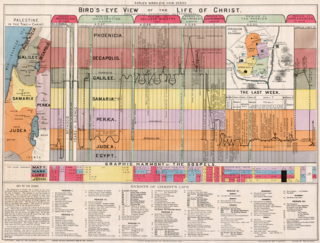
A chronology of Jesus aims to establish a timeline for the events of the life of Jesus. Scholars have correlated Jewish and Greco-Roman documents and astronomical calendars with the New Testament accounts to estimate dates for the major events in Jesus's life.

The life of Jesus is primarily outlined in the four canonical gospels, which includes his genealogy and nativity, public ministry, passion, prophecy, resurrection and ascension. Other parts of the New Testament – such as the Pauline epistles which were likely written within 20 to 30 years of each other, and which include references to key episodes in the life of Jesus, such as the Last Supper, and the Acts of the Apostles, which includes more references to the Ascension episode than the canonical gospels also expound upon the life of Jesus. In addition to these biblical texts, there are extra-biblical texts that make reference to certain events in the life of Jesus, such as Josephus on Jesus and Tacitus on Christ.
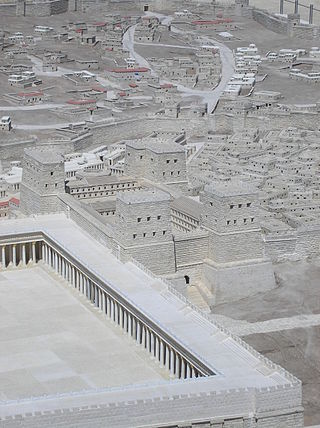
The Antonia Fortress was a citadel built by Herod the Great and named for Herod's patron Mark Antony, as a fortress whose chief function was to protect the Second Temple. It was built in Jerusalem at the eastern end of the Second Wall, at the north-western corner of the Temple Mount, and was connected to the Temple by porticoes.
The Latin term praetorium originally identified the tent of a general within a Roman castrum (encampment), and derived from the title praetor, which identified a Roman magistrate. Originally, praetor ("leader") was the title of the ranking civil servant in the Roman Republic, but later identified a rank of office below the rank of consul.

The New Testament narrative of the life of Jesus refers to several locations in the Holy Land and a Flight into Egypt. In these accounts the principal locations for the ministry of Jesus were Galilee and Judea, with activities also taking place in surrounding areas such as Perea and Samaria. Other places of interest to scholars include locations such as Caesarea Maritima where in 1961 the Pilate stone was discovered as the only archaeological item that mentions the Roman prefect Pontius Pilate, by whose order Jesus was crucified.

Matthew 27 is the 27th chapter in the Gospel of Matthew, part of the New Testament in the Christian Bible. This chapter contains Matthew's record of the day of the trial, crucifixion and burial of Jesus. Scottish theologian William Robertson Nicoll notes that "the record of this single day is very nearly one-ninth of the whole book".

Gabbatha is the name of a place in Jerusalem that is also referred to by the Greek name of Lithostrōtos. It is recorded in the gospels to be the place of the trial of Jesus before his crucifixion c. 30/33 AD. The site of the Church of Ecce Homo is traditionally thought to be its location, but archaeological investigation has proven this unlikely. Herod's Palace is a more likely location.
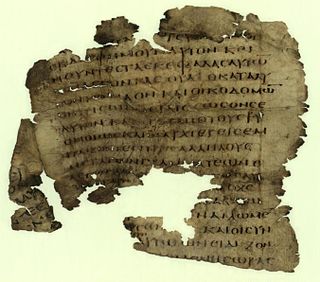
Mark 15 is the fifteenth chapter of the Gospel of Mark in the New Testament of the Christian Bible. This chapter records the narrative of Jesus' passion, including his trial before Pontius Pilate and then his crucifixion, death and entombment. Jesus' trial before Pilate and his crucifixion, death, and burial are also recorded in Matthew 27, Luke 23, and John 18:28–19:42.

John 18 is the eighteenth chapter of the Gospel of John in the New Testament of the Christian Bible. This chapter records the events on the day of the Crucifixion of Jesus, starting with the arrest of Jesus the evening before. The three denials of Peter are interwoven into the narrative concerning the trials of Jesus.

Luke 23 is the twenty-third chapter of the Gospel of Luke in the New Testament of the Christian Bible. The book containing this chapter is anonymous, but early Christian tradition uniformly affirmed that Luke the Evangelist composed this Gospel as well as the Acts of the Apostles. This chapter records the trial of Jesus Christ before Pontius Pilate, Jesus' meeting with Herod Antipas, and his crucifixion, death and burial.

In the New Testament, the Sanhedrin trial of Jesus refers to the trial of Jesus before the Sanhedrin following his arrest in Jerusalem and prior to the trial before Pontius Pilate. It is an incident reported by all three Synoptic Gospels of the New Testament, while the Gospel of John refers to a preliminary inquiry before Annas. The gospel accounts vary on a number of details.

Matthew 27:2 is the second verse of the twenty-seventh chapter of the Gospel of Matthew in the New Testament. Jesus has been condemned by the Jewish Sanhedrin, and in this verse is handed over to Pontius Pilate.
The persecution of Christians in the New Testament is an important part of the Early Christian narrative which depicts the early church as being persecuted for their heterodox beliefs by a Jewish establishment in the Roman province of Judea. The New Testament, especially the Gospel of John, has traditionally been interpreted as relating Christian accounts of the Pharisee rejection of Jesus and accusations of the Pharisee responsibility for his crucifixion. The Acts of the Apostles depicts instances of early Christian persecution by the Sanhedrin, the Jewish religious court.

The following outline is provided as an overview of and topical guide to Christianity:
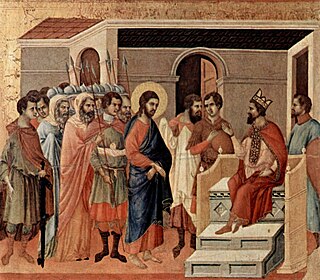
Jesus at Herod's court refers to an episode in the New Testament which describes Jesus being sent to Herod Antipas in Jerusalem, prior to his crucifixion. This episode is described in Luke 23.
Passion Gospels are early Christian texts that either mostly or exclusively relate to the last events of Jesus' life: the Passion of Jesus. They are generally classed as New Testament apocrypha. The last chapters of the four canonical gospels include Passion narratives, but later Christians hungered for more details. Just as infancy gospels expanded the stories of young Jesus, Passion Gospels expanded the story of Jesus's arrest, trial, execution, resurrection, and the aftermath. These documents usually claimed to be written by a participant mentioned in the gospels, with Nicodemus, Pontius Pilate, and Joseph of Arimathea as popular choices for author. These documents are considered more legendary than historical, however, and were not included in the eventual Canon of the New Testament.


